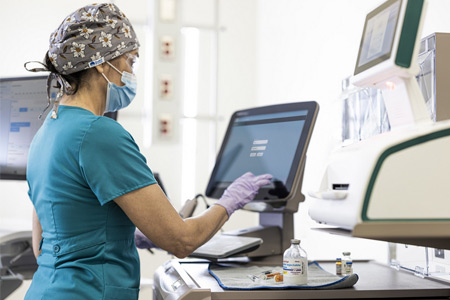BD a leading global medical technology company, announced new data that highlights how its advanced artificial intelligence technology can help health systems better identify incidents of controlled substance diversion in the operating room.
Hospital drug diversion occurs when a health care worker "diverts" opioids or other controlled substances away from patients for personal use or sale. The operating room is one of the highest risk areas for the diversion of controlled substances, such as narcotics used for anesthesia and pain management.
A new research study1 conducted at an Ochsner Health medical center and published in the American Journal of Health-System Pharmacy (AJHP) shows how the use of artificial intelligence in BD HealthSightTM Diversion Management software can help highlight blind spots about the movement of medication in the operating room that are undetected by current manual processes. This system uses artificial intelligence and advanced analytics to provide a deep level of connectivity and visibility into the behaviors of individuals interacting with medication storage, management and pharmacy systems, which is a critical need for large, complex health systems with hundreds of points of controlled substance dispensing across multiple sites.
"In health care, where patient care is crucial, being able to spot potential issues like drug diversion is not only important but a moral duty," said Alexandre P. Raymond, PharmD, MS, director for Drug Diversion Prevention & Response, Compliance at Ochsner Health. "The results of our research study underscore the transformative power of advanced analytics software, powered by machine-learning algorithms, in helping health systems not only meet their goals but also drive tangible value. This technology equips health care providers with the tools needed to safeguard patients, uphold integrity and combat drug diversion effectively."
After implementing BD HealthSightTM Diversion Management software, the Ochsner facility observed a 55% increase in the number of charting discrepancies. This increase is attributed to the software's ability to track a broader range of discrepancies than was previously possible with existing procedures at the study site, such as whole dose waste, cancelled transactions and drugs dispensed after patient discharge.
The study also highlighted efficiency improvements in the facility's efforts to reconcile incidents of potential drug diversion in the operating room. Despite the increase in the volume of charting discrepancies, the percentage of incidents that were able to be resolved by the operating room analyst increased by 14% after software implementation and the number of cases requiring additional documentation by providers decreased by 10%. When a full investigation was required, the software reduced the time required for an auditor to review referred cases of potential diversion from an average of three business days to 50 minutes.
The study measured the facility's ability to identify, reconcile and investigate potential incidents of drug diversion across their 34 operating rooms where more than 55,000 surgeries are performed and more than 100,000 doses of controlled substances are dispensed annually.
In 2019, BD issued a report, Health Care's Hidden Epidemic: A Call to Action on Hospital Drug Diversion2, based on a national survey that examined drug diversion in U.S. hospitals. When this report was issued, survey results found that drug diversion was largely considered a taboo subject for health care leaders and many believed it was not an issue in their own hospitals.
This new study data builds on the 2019 report and illustrates that drug diversion remains a significant issue and that there is an opportunity for advancements in technology to provide solutions to identifying and investigating incidents of potential drug diversion.
For more information please visit www.bd.com


